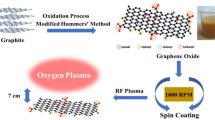Abstract
Graphene oxide (GO) foils, synthesized with the Hummers’ method, were IR laser treated in air and under vacuum at some laser fluences (300 and 600 mJ/cm2 in air and 200 mJ/cm2 under vacuum). Depending on the laser fluence and the used environment, it was possible to control the oxidation or reduction degree of GO foils. The evolution of the structural and compositional characteristics of the as-prepared GO films was examined through different physical characterization techniques. In particular, scanning electron microscopy (SEM), surface profilometry, energy-dispersive X-ray spectroscopy (EDX), Rutherford backscattering spectrometry (RBS) and X-ray photoelectron spectroscopy (XPS) were used. A preliminary Raman analysis was also carried out on some GO foils. The results suggest the gradual restoration of sp2 clusters within the sp3 matrix under vacuum or in air at high laser fluences. In these conditions, the partial reestablishment of planarity and an increase in the D/G intensity ratio are also observed. In air, at low laser fluences, the IR laser irradiation causes GO films oxidation, increase in roughness and greater exfoliation availability. The useful deduced information about morphology and composition make the IR laser treatment a simple method for controlling the physical properties of GO film by tailoring the oxygen functional groups, and consequently, for the production of tailor-made highly conductive and defect-free graphene-like materials or GO composites with metals and organic molecules or GO doped with heteroatoms.











Similar content being viewed by others
References
F. Li, X. Jiang, J. Zhao, S. Zhang, Nano Energy 16, 488–515 (2015)
X.-F. Jiang, L. Polavarapu, S.T. Neo, T. Venkatesan, Q.-H. Xu, J. Phys. Chem. Lett. 3, 785–790 (2012)
A. Lerf, H.Y. He, M. Forster, J. Klinowski, Structure of graphite oxide revisited. J. Phys. Chem. B 102, 4477–4482 (1998)
J.A. Yan, M.Y. Chou, Oxidation functional groups on graphene: structural and electronic properties. Phys. Rev. B 82, 125403 (2010)
J.A. Yan, L. Xian, M.Y. Chou, Structural and electronic properties of oxidized graphene. Phys. Rev. Lett. 103, 086802 (2009)
L. Liu, L. Wang, J. Gao, J. Zhao, X. Gao, Z. Chen, Amorphous structural models for graphene oxides. Carbon 50, 1690–1698 (2012)
N. Morimoto, T. Kubo, Y. Nishina, Tailoring the oxygen content of graphite and reduced graphene oxide for specific applications. Sci. Rep. 6, 21715 (2016)
L. Huang, Y. Liu, L.C. Ji, Y.Q. Xie, T. Wang, W.Z. Shi, Pulsed laser assisted reduction of graphene oxide. Carbon 49, 2431–2436 (2011)
L.J. Cote, R. Cruz-Silva, J. Huang Flash reduction and patterning of graphite oxide and its polymer composite. J. Am. Chem. Soc. 131, 11027–11032 (2009)
R. Maiti, A. Midya, C. Narayana, S K. Ray, Tunable optical properties of graphene oxide by tailoring the oxygen functionalities using infrared irradiation. Nanotechnology 25, 495704 (2014)
S. Bhattachraya, R. Maiti, A.C. Das, S. Saha, S. Mondal, S.K. Ray, S.N.B. Bhaktha, P. K. Datta, Efficient control of ultrafast optical nonlinearity of reduced graphene oxide by infrared reduction. J. Appl. Phys. 120, 013101 (2016)
L. Torrisi, L. Silipigni, M. Cutroneo, Radiation effects of IR laser on graphene oxide irradiated in vacuum and in air. Vacuum 153, 122–131 (2018)
R. Trusovas, K. Ratautas, G. Račiukaitis, J. Barkauskas, I. Stankevičien, G. Niaura, R. Mazěikien, Reduction of graphite oxide to graphene with laser irradiation. Carbon 52, 574–582 (2013)
L. Huang, Y. Liu, Le-C. Ji, Yi-Q. Xie, T. Wang, W.-Z. Shi, Pulsed laser assisted reduction of graphene oxide. Carbon 49, 2431–2436 (2011)
P. Malinský, A. Macková, R. Mikšová, H. Kováčiková, M. Cutroneo, J. Luxac, D. Boušac, B. Štrochovác, Z. Sofer, Graphene oxide layers modified by light energetic ions. Phys. Chem. Chem. Phys. 19, 10282–10291 (2017)
J. Vegh, Sloping Shirley-type inelastic line shapes. Surf. Interface Anal. 20, 860–862 (1993)
J. Ziegler, SRIM—the stopping and range of ions in matter, actual website 2018. http://www.srim.org/
J. Ziegler, SREM, The Stopping and Range of Electrons in Matter, actual website 2018. http://www.srim.org/SREM.htm
K. Satyendra, S.N. Mishra, V. Tripathi, B.D. Choudhary, Gupta, SPR based fibre optic ammonia gas sensor utilizing nanocomposite film of PMMA/reduced graphene oxide prepared by in situ polymerization. Sens Actuators B 199, 190–200 (2014)
E. Rimini, Energy deposition and heat flow for pulsed laser electron and ion beam irradiation, ed. by J.M. Poate, G. Foti, D.C. Jacobson Plenum. Surface modification and alloying, vol 8 (Springer, Boston, MA, 1983), pp. 15–49.
K.A. Mkhoyan, A.W. Contryman, J. Silcox, D.A. Stewart, G. Eda, C. Mattevi, S. Miller, M. Chhowalla, Atomic and electronic structure of graphene-oxide. Nanoletters 9, 1058–1063 (2009)
K. Krishnamoorthy, M. Veerapandian, K. Yun, S.J. Kim, The chemical and structural analysis of graphene oxide with different degrees of oxidation. Carbon 53, 38–49 (2013)
S. Stankovich, D.A. Dikin, R.D. Piner, K.A. Kohlhaas, A. Kleinhammes, Y. Jia, Y. Wu, S.B.T. Nguyen, R.S. Ruoff, Synthesis of graphene-based nanosheet via chemical reduction of exfoliated graphite oxide. Carbon 45, 1558–1565 (2007)
L. Silipigni, L. Torrisi, M. Cutroneo, EPJ Web Conf. 167, 05011 (2018). https://doi.org/10.1051/epjconf/201816705011 (PPLA 2017)
R. Trusovas, G. Racˇiukaitis, G. Niaura, J. Barkauskas, ,G. Valušis, R. Pauliukaite, Recent advances in laser utilization in the chemical modification of graphene oxide and its applications. Adv. Optical Mater. 4, 37–65 (2016)
Acknowledgements
This work is supported by Università degli Studi di Messina in ambit of the International Project “Research and Mobility” coordinated by Prof. L. Torrisi, Project no. 74893496. The research has been also supported by GACR No 16-05167S and by OP RDE, MEYS, Czech Republic under the project CANAM OP, CZ.02.1.01./0.0/0.0/16_013/0001812.
Author information
Authors and Affiliations
Corresponding author
Rights and permissions
About this article
Cite this article
Silipigni, L., Fazio, M., Fazio, B. et al. Tailoring the oxygen content of graphene oxide by IR laser irradiation. Appl. Phys. A 124, 545 (2018). https://doi.org/10.1007/s00339-018-1956-z
Received:
Accepted:
Published:
DOI: https://doi.org/10.1007/s00339-018-1956-z




